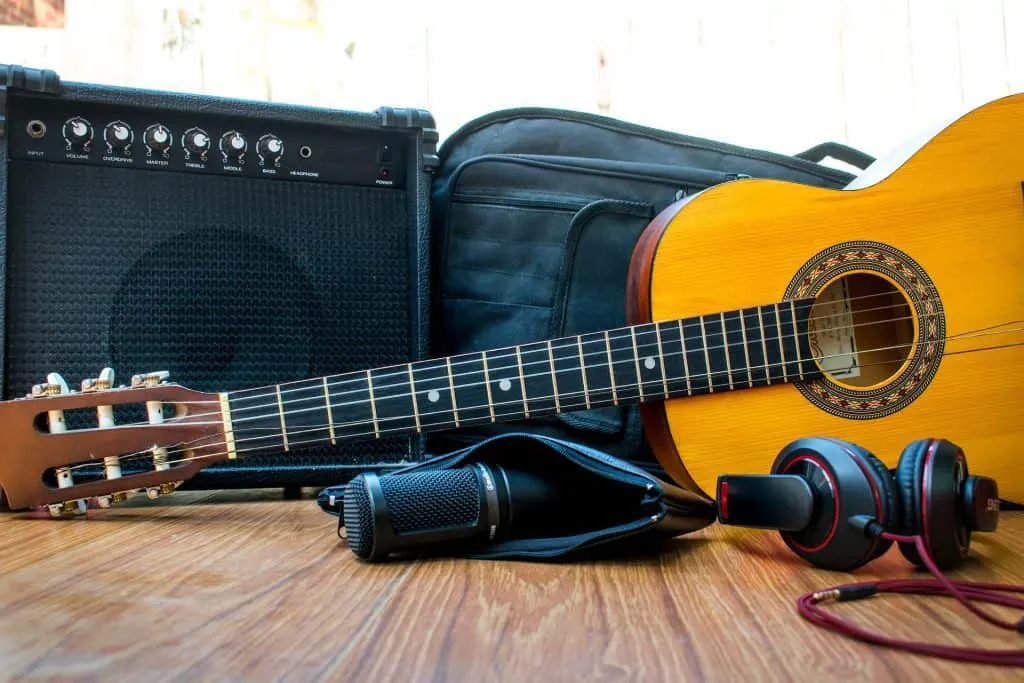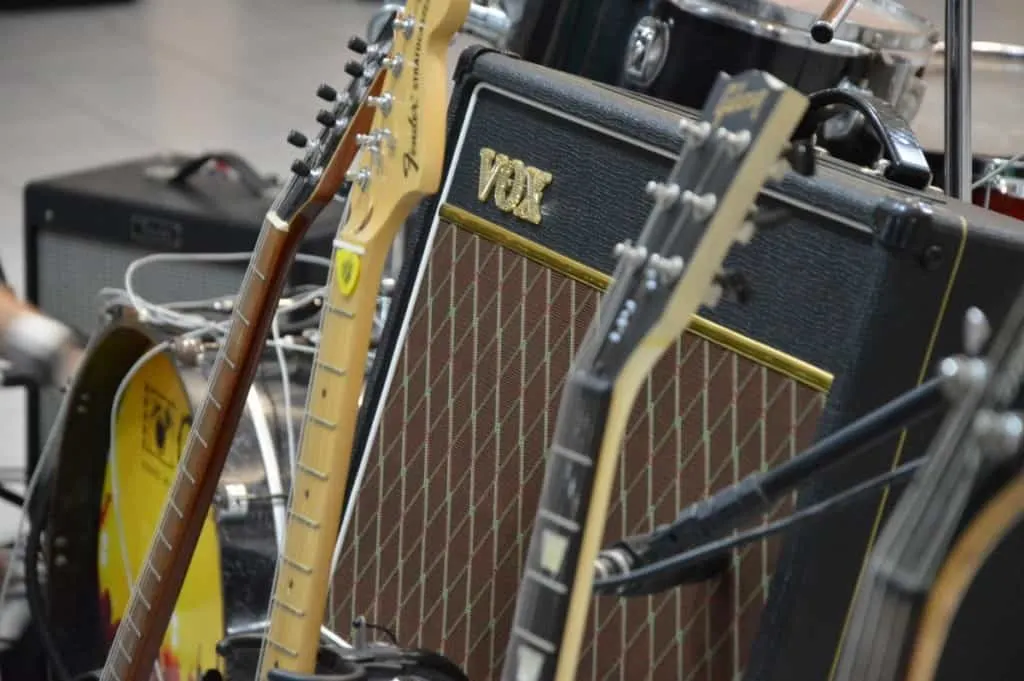The most effective way to record guitar is a constant topic of debate amongst musicians and recording engineers. To choose the best-suited microphone, it’s important to establish the results you’re aiming for.
Can you record a guitar with a condenser mic?
Condenser microphones are well adept at capturing the slight nuances of a guitar. Additionally, condenser microphones provide precise attention to detail and are capable of recording the instrument’s higher-frequencies with impressive clarity.
With that being said, whether a condenser mic is the best choice for recording a guitar depends on several factors.
The style, tone, and effects you intend to use all have a significant impact. In this detailed guide, we’ll discuss the various factors so that you have all of the necessary information on recording guitar with a condenser mic at your disposal.

Recording A Guitar With A Condenser Microphone
Condenser microphones are best suited to recording instruments that produce an abundance of high frequencies. Guitars fall into this category, but it depends on the style in question. Generally speaking, acoustic guitars interact very well with condenser mics, due to their high-end, detailed frequency range.
The majority of good-quality condenser mics have a wide frequency range, spanning from around 20 Hz – 20 kHz. Compared to its dynamic counterparts, a condenser microphone offers superior sound quality. This is largely due to the low-mass of its inner components.
A popular choice for a good all-round condenser microphone is the Rode NT-1. This microphone has been well received over the last few years, it has the perfect frequency range and low self-noise which is also super important.
Check out the popular Rode NT-1 here on Amazon
If you are unaware of what self-noise on a microphone is, and why it’s super important to minimize it, check out this article
Another quality that makes condenser mics well suited to recording acoustic guitar is their exceptional transient response. If you’re not familiar with transients, they are simply the peaks and troughs of an audio wave, for example, when a plectrum hits the string on an acoustic guitar, a transient is produced.
Condensers also boast higher sensitivity than dynamic microphones.
This is an important quality for recording the acoustic guitar because much of the sound comes from the player’s style of strumming, picking, or the dynamics of their playing. Harmonics are also very common on acoustic guitar, and a condenser can pick them up clearly.
Moving on from acoustic guitars, let’s explore the subject of recording the amplified electric guitar with a condenser. This is more complex than acoustic guitars, due to the versatile voicings that an electric is capable of producing – especially when effects pedals are used.
It’s still very common for mixing engineers and producers to use a condenser mic to capture a guitar amp, but unlike recording an acoustic, where a single mic would be all that is required, a dynamic microphone is likely to be paired with a condenser for this purpose.
I have written an article that discusses the difference between large and small condenser microphones. You can read it here.
Take a look at this Youtube video for more useful tips when recording guitars.
Large-diaphragm condensers are great for recording a guitar amp, due to their extensive frequency response, especially in the low-end. These microphones slightly diffuse the sound, resulting in a softer tone. When paired with a reliable dynamic mic, like the industry-standard Shure SM57 for example, the combination can capture the whole range of frequencies and sonic colors produced by an electric guitar.
Check out the ever-popular Shure SM57 here on Amazon
It’s important to note that condenser mics are not a one-size-fits-all solution. Within the field, various types of condensers are categorized by their polar pattern. The polar pattern of the microphone has a notable impact on its performance and capabilities.
The only issue that is likely to arise when recording the electric guitar with a condenser mic, is clipping. This occurs when the guitar’s volume is too loud for the microphone to handle, and causes the waveform to become saturated, leading to distortion.
Providing that you play your guitar at a reasonable level, and don’t crank the volume on your amp too high, condensers will work just fine. However, their SPL (sound pressure level) sensitivity makes them susceptible to distorting when the guitar is loud.
Recording guitar with a condenser mic is not only possible if done correctly, but it’s also highly recommended. There’s no other type of microphone that is capable of capturing the wide frequency range of a guitar with such clarity and precision.

How To Position A Condenser Microphone For Recording Guitar
The placement of a condenser mic when recording guitar is hugely impactful on the result. There are several techniques and theories that are commonly used, both for recording an acoustic guitar or mic’ing up an amplifier.
When recording an amplified guitar with a condenser, it’s important to consider that if the mic is positioned too close to the speaker, there’s a chance that the signal will be too hot and result in unwanted saturation.
The prominence of high-end frequencies in your signal will change in relation to the angle of the condenser mic. If you are looking for a bright and sharp-sounding tone, this can be achieved by pointing the capsule directly at the center of the amp’s speaker cone.
Alternatively, if you want to reduce some of the brightness from your recording, you should angle the condenser towards the outer edge of the speaker cone. This will result in an overall warmer tone, where the mid and bass frequencies become more noticeable.
It’s common to see recording engineers positioning microphones tightly against the grill of a guitar amp. Although this is a good technique for enhancing the bass frequencies and capturing natural distortion, it’s more difficult with a condenser mic than a dynamic or ribbon mic, due to the higher sensitivity to loud volumes.
Recording acoustic guitar using a condenser mic is less complex, but still requires attention. The first rule of thumb to obey is to avoid positioning the condenser directly in front of the guitar’s soundhole. Although it may seem logical to do so, this will result in a chaotic recording due to the mix of bass frequencies that resonate in the body of the guitar and exit through its soundhole.
A better place to position the condenser would be level with the 12th fret of the acoustic guitar, around 1 ft away from it. This is considered to be the sweet spot of the guitar, as it captures the frequencies from all of the strings and the percussive, rhythmic sounds played with the strumming or picking hand.
I have written an article on how to record acoustic guitar without capturing the pick noise. You can read it here.
Polar Patterns
You’ve probably come across the term “polar pattern” when researching condenser microphones. To put it simply, the polar pattern of the mic is akin to its ability to pick up sound sources from different directions. The main types of polar patterns found in condenser mics are:
- Cardioid
- Omnidirectional
- Super-Cardioid
- Figure of Eight
Choosing the right polar pattern for your style of guitar playing is essential if you want to get the best recordings possible. Some are better suited to intimate, low-volume fingerpicked guitar playing, while others can handle fuzzy-draped metal riffs.
- The most common polar pattern you’ll find in a condenser is cardioid.
These capsules are highly sensitive at the front end, and not so much at the rear. The advantage of this is that it prevents background noises from creeping into the recordings, and only captures what is positioned in front of the mic.
This quality makes cardioid polar patterns a suitable choice for recording guitar, especially in a live setting where other instruments are also playing.
Check out this informative Youtube video that demonstrates Polar Patterns.
Omnidirectional polar patterns are also commonly found in condenser mics. As the name suggests, they can record sound from all directions around the capsule. For recording acoustic guitar, this is useful as it picks up the reverb that bounces off the walls, resulting in a resonant and warm recording.
Condenser mics that house super-cardioid polar patterns are ideal for focusing solely on a single sound source, and blocking out almost all ambient sound. There is a tiny amount of pickup at their back end, but their ability to hone in on a guitar makes them a good choice for live recordings.
Finally, it’s worth mentioning figure of eight, or bidirectional polar patterns. Condenser mics of this variety capture sound directly in front, and directly behind the capsule, rejecting any sound sources positioned to the sides. These are great for recording two guitars simultaneously, or a guitarist and a vocalist.

Large Diaphragm vs. Small Diaphragm Condenser Mics
Now that we’ve firmly established that condenser mics are great choices for recording guitar, let’s explore some of the finer details.
Condenser mics fall into one of two categories, depending on the size of their diaphragm. This, in addition to the polar pattern, impacts the mic’s effectiveness at recording guitar significantly.
Here are the main qualities of each type of condenser:
| Large Diaphragm Condenser | Small Diaphragm Condenser |
| · Extensive frequency response | · Flatter frequency response |
| · Prominent low-end | · More focused sound |
| · Soft overall tone | · High gain & low noise |
| · A slight boost in the 5kHz-15kHz | · Great for close-up micing |
Related Questions
Do you need phantom power to record guitar with a condenser mic?
Phantom power is a necessity for almost all condenser microphones. It is usually provided by an audio interface, with a switch labeled +48v Phantom Power. Without it, the majority of condensers won’t record audio.
- Take note that most ribbon microphones don’t usually require phantom power. Check out my article on ribbon microphones here.
- If you don’t know what phantom power is, or if you need it with your microphone check out this article.
Should you use headphones when recording guitar?
Headphones are vital if you don’t want spill to be present in your recordings. If you record guitar using studio monitors, any backing tracks, click tracks or previous recordings will be played back into the microphone.
Can you use a condenser to record a guitar with effects pedals?
Distortion-based effects pedals pose a challenge to most condenser microphones, due to their high-sensitivity. Dynamic mics are usually chosen for loud guitar recordings, but for effects like reverb, delay, or modulation, condensers work just fine.
Whichever way you decide to record be sure to enjoy the process.
Happy Recording!
